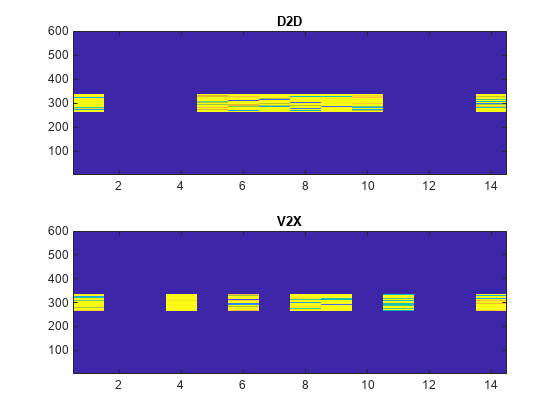ltePSBCHIndices
PSBCH resource element indices
Description
ind = ltePSBCHIndices(ue)
Examples
Generate PSBCH values and indices. Write the values into the PSBCH resource elements in a synchronization subframe for both D2D and V2X sidelink modes, and display an image of their locations. This mapping also writes the PSBCH values into the last SC-FDMA guard symbol within a subframe. The sidelink SC-FDMA modulator removes PSBCH values from the last SC-FDMA guard symbol in a separate processing step.
Create a user equipment settings structure and a resource grid that has 10 MHz bandwidth and normal cyclic prefix for D2D sidelink mode.
ue.NSLRB = 50;
ue.CyclicPrefixSL = 'Normal';
ue.NSLID = 1;Generate an empty resource grid and PSBCH indices. Load the PSBCH indices into the resource grid.
grid_D2D = lteSLResourceGrid(ue); psbch_indices = ltePSBCHIndices(ue); grid_D2D(psbch_indices) = ltePSBCH(ue,zeros(2*576,1));
Change user equipment settings to V2X sidelink mode.
ue.SidelinkMode = 'V2X';Generate an empty resource grid and PSBCH indices. Load the PSBCH indices into the resource grid.
grid_V2X = lteSLResourceGrid(ue); psbch_indices = ltePSBCHIndices(ue); grid_V2X(psbch_indices) = ltePSBCH(ue,zeros(2*504,1));
Display the locations of the PSBCH indices for both sidelink modes.
subplot(2,1,1); image(400*abs(grid_D2D)); axis xy; title('D2D'); subplot(2,1,2); image(400*abs(grid_V2X)); axis xy; title(ue.SidelinkMode);

Generate PSBCH indices using zero-based indexing style. Compare these indices to one-based indices.
Create a user equipment settings structure with 10 MHz bandwidth and normal cyclic prefix.
ue.NSLRB = 50;
ue.CyclicPrefixSL = 'Normal';
ue.NSLID = 1;Generate PSBCH zero-based indices. View the first five indices.
psbch_indices = ltePSBCHIndices(ue,'0based');
psbch_indices_size = size(psbch_indices)psbch_indices_size = 1×2
576 1
psbch_indices(1:5)
ans = 5×1 uint32 column vector
264
265
266
267
268
Generate PSBCH one-based indices and view the first five indices.
psbch_indices = ltePSBCHIndices(ue,'1based');
psbch_indices_size = size(psbch_indices)psbch_indices_size = 1×2
576 1
psbch_indices(1:5)
ans = 5×1 uint32 column vector
265
266
267
268
269
For zero-based indexing, the first assigned index is one lower than the one-based indexing style.
Input Arguments
User equipment settings, specified as a parameter structure containing these fields:
Sidelink mode, specified as 'D2D' or
'V2X'.
Data Types: char | string
Number of sidelink resource blocks, specified as an integer scalar from 6 to 110.
Example: 6, which corresponds to a channel
bandwidth of 1.4 MHz.
Data Types: double
Cyclic prefix length, specified as 'Normal' or 'Extended'.
Data Types: char | string
Output format options for resource element indices, specified as a character vector, cell
array of character vectors, or string array. For convenience, you can
specify several options as a single character vector or string scalar by a
space-separated list of values placed inside the quotes. Values for
opts when specified as a character vector include
(use double quotes for string) :
| Category | Options | Description |
|---|---|---|
| Indexing style |
| The returned indices are in linear index style. |
| The returned indices are in | |
| Index base |
| The returned indices are one-based. |
| The returned indices are zero-based. |
Example: 'ind 1based', "ind 1based",
{'ind','1based'}, or ["ind","1based"] specify
the same formatting options.
Data Types: char | string | cell
Output Arguments
PSBCH resource element indices, returned as an integer column vector or a three-column integer matrix. By default, the returned vector or matrix has 576 PSBCH resource element indices for normal cyclic prefix or 432 PSBCH resource element indices for extended cyclic prefix. For the V2X sidelink mode, there are 504 PSBCH resource element indices. For more information, see Physical Sidelink Broadcast Channel Indexing.
Data Types: uint32
More About
Use the ltePSBCHIndices indexing
function and the corresponding ltePSBCH sequence
function to populate the resource grid for the desired synchronization
subframe number. The indices are ordered as the PSBCH QPSK modulation
symbols should be mapped, applying frequency-first mapping, and include
indices for the last SC-FDMA guard symbol. The PSBCH values returned
by ltePSBCH are ordered as they
should be mapped into the resource elements of the adjacent symbols
using ltePSBCHIndices. For more
information on mapping symbols to the resource element grid, see Resource Grid Indexing.
The physical sidelink broadcast channel (PSBCH) is transmitted in the central
72 resource elements in the available SC-FDMA symbols of synchronization subframes. For D2D
sidelink mode, the available symbols exclude the three symbols per slot assigned to the
PSBCH DRS and sidelink synchronization signals. For V2X sidelink, a total of seven symbols
will be excluded in a subframe (three symbols for PSBCH DRS and 4 for the PSSS/SSSS). The
resource elements in the last SC-FDMA symbol within a subframe are counted in the mapping
process. Before transmission, the PSBCH resource elements are removed from the last SC-FDMA
symbol by lteSCFDMAModulate during the sidelink-specific
SC-FDMA modulation and guard symbol creation.
If a terminal is transmitting a synchronization subframe, then it should be sent every 40 ms
for D2D sidelink mode or every 160 ms for V2X, with the exact subframe dependent on the
RRC-signaled subframe number offset (syncOffsetIndicator-r12). The
subframe also contains values for the ltePSBCHDRSIndices on port 1010 and ltePSSSIndices and lteSSSSIndices on port 1020. No PSCCH or PSSCH transmission will occur in a
sidelink subframe configured for synchronization purposes.
Version History
Introduced in R2016b
See Also
ltePSBCH | ltePSBCHDecode | ltePSBCHDRSIndices | lteSLBCHDecode
MATLAB Command
You clicked a link that corresponds to this MATLAB command:
Run the command by entering it in the MATLAB Command Window. Web browsers do not support MATLAB commands.
选择网站
选择网站以获取翻译的可用内容,以及查看当地活动和优惠。根据您的位置,我们建议您选择:。
您也可以从以下列表中选择网站:
如何获得最佳网站性能
选择中国网站(中文或英文)以获得最佳网站性能。其他 MathWorks 国家/地区网站并未针对您所在位置的访问进行优化。
美洲
- América Latina (Español)
- Canada (English)
- United States (English)
欧洲
- Belgium (English)
- Denmark (English)
- Deutschland (Deutsch)
- España (Español)
- Finland (English)
- France (Français)
- Ireland (English)
- Italia (Italiano)
- Luxembourg (English)
- Netherlands (English)
- Norway (English)
- Österreich (Deutsch)
- Portugal (English)
- Sweden (English)
- Switzerland
- United Kingdom (English)